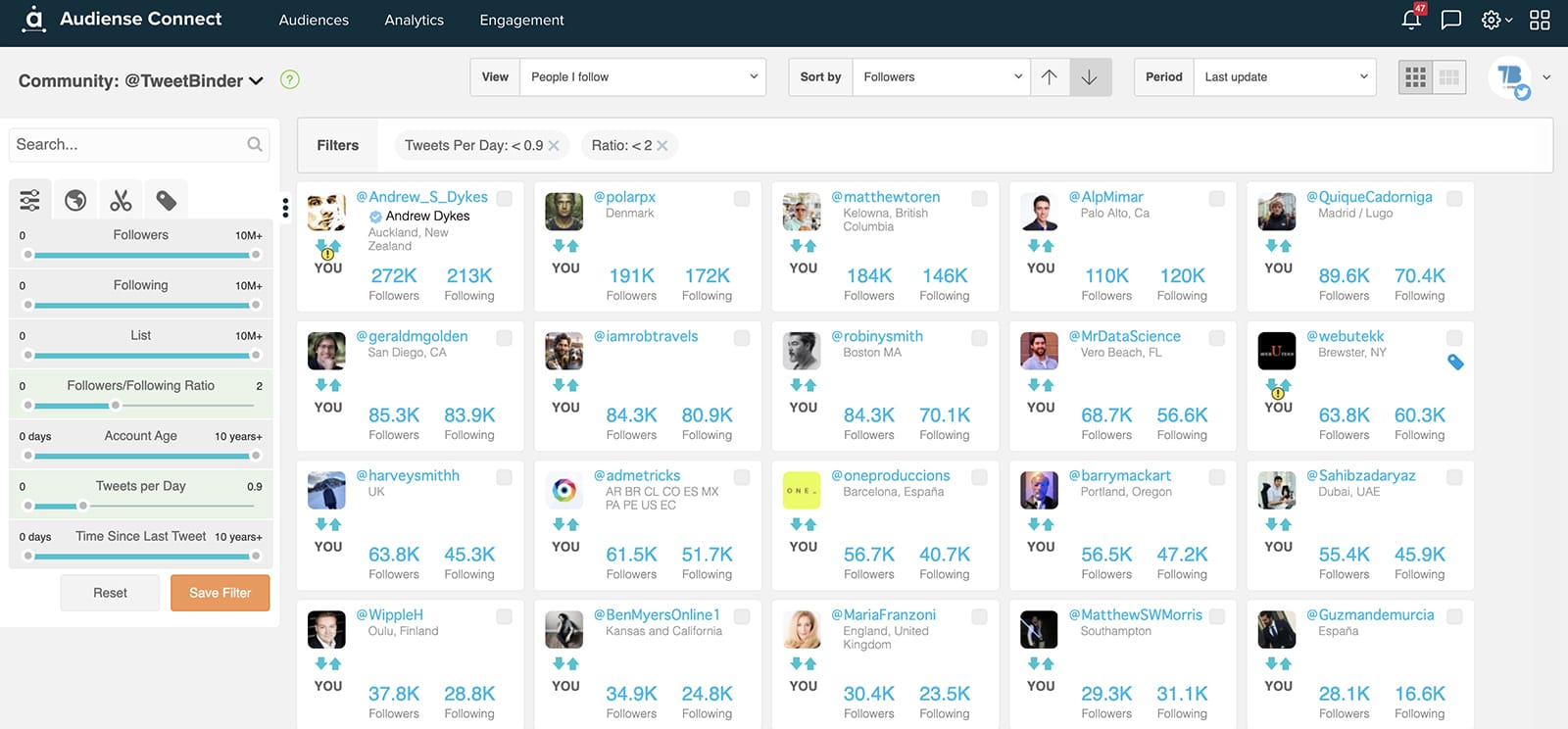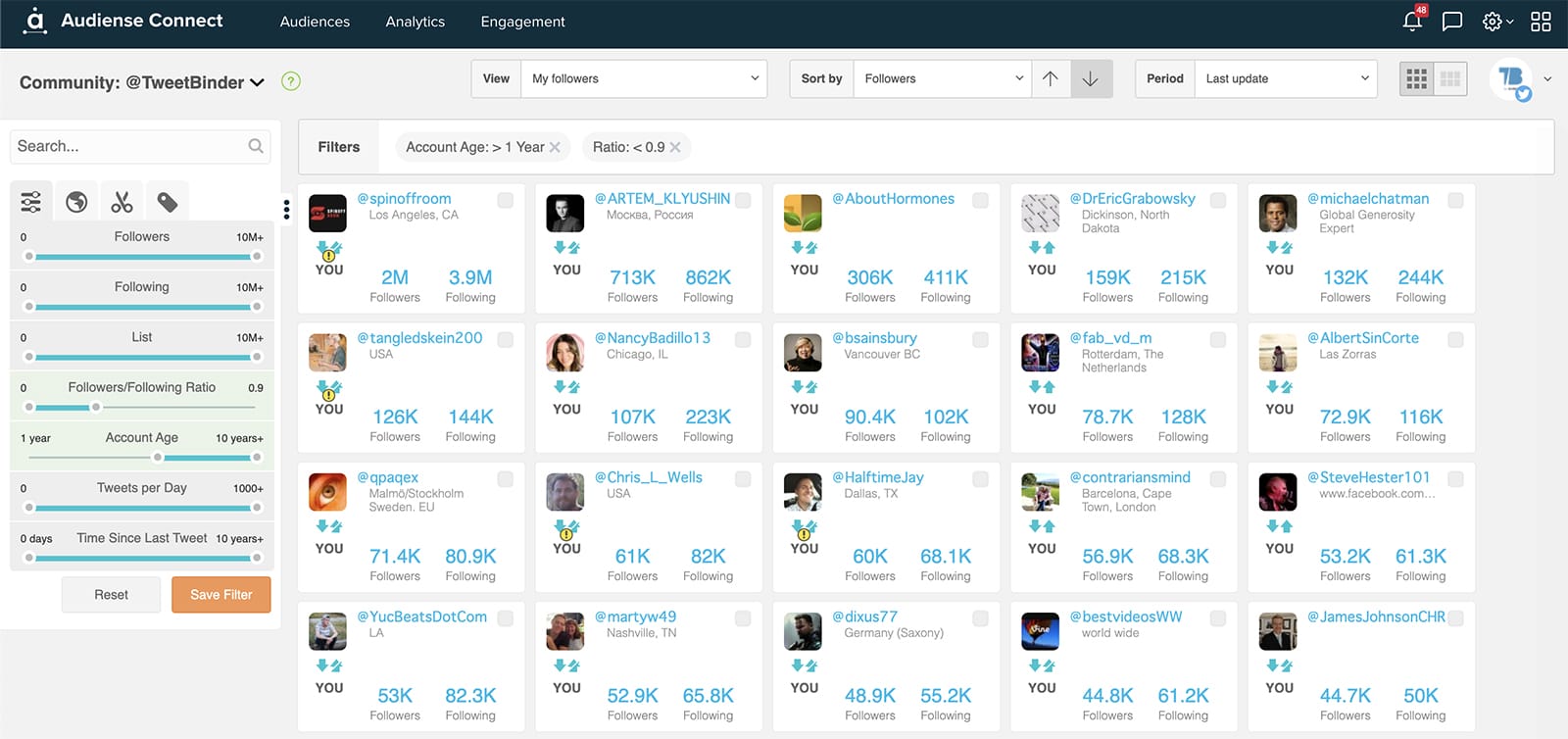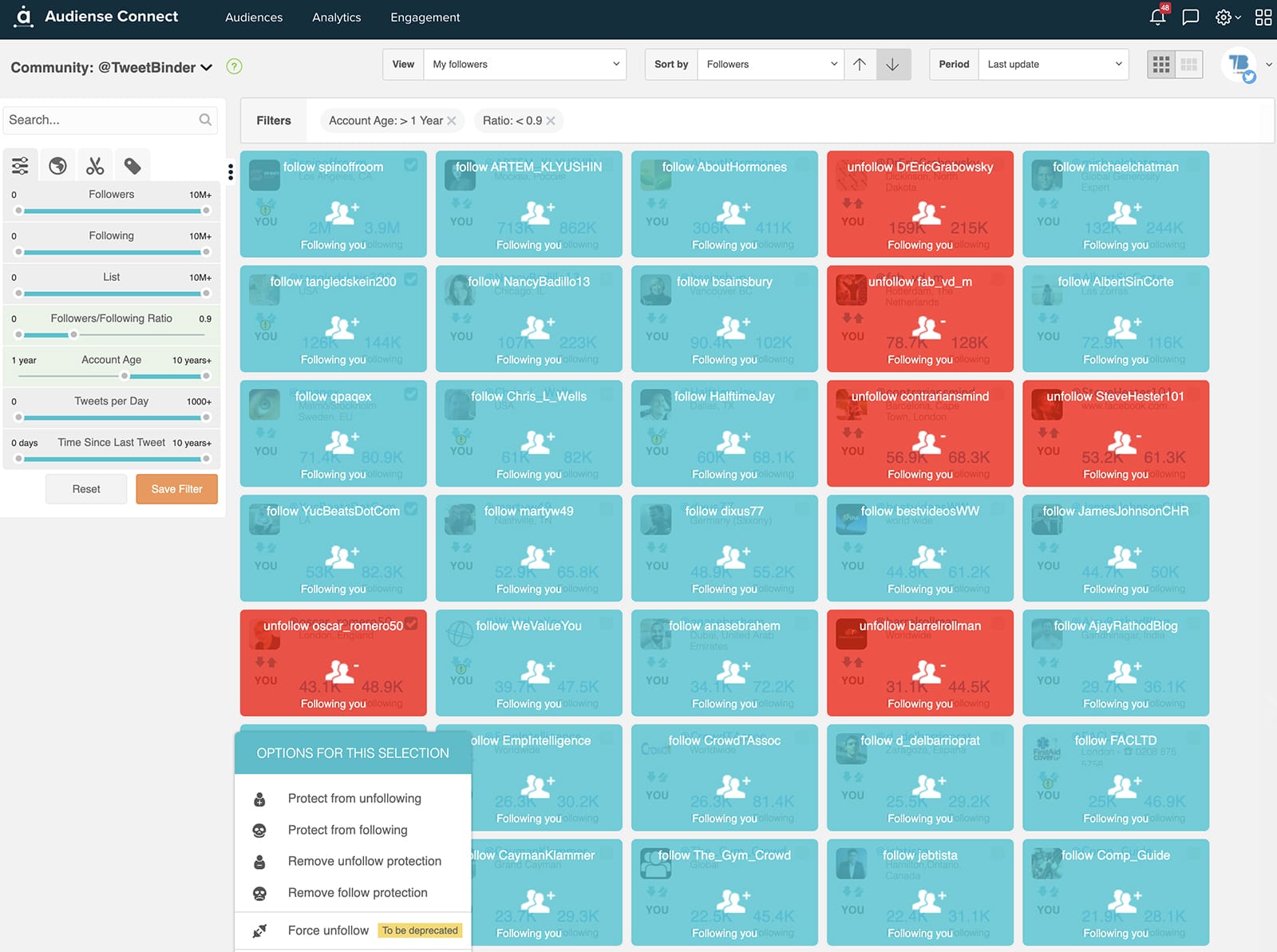Want to improve your Twitter follower ratio so you can build social proof and gain influence on Twitter?
In this article, we’ll cover:
- why this metric matters so much;
- how to achieve the ideal ratio for your Twitter account;
- how to segment your Twitter community based on the Twitter follower ratio.
What does follower ratio mean on Twitter / X?
A Twitter follower ratio compares the number of people a user follows to the number of followers the account has. You can also call it a follower to following ratio.
It’s easy to view follower ratio as a vanity metric. In fact, some people dismiss it as the “cool ratio.”
However, it’s an important metric to monitor. It can tell you a lot about how popular an account is and how much influence it has.
By monitoring your own Twitter ratio, you can craft an account that looks as high-quality as possible. You can also check other accounts’ ratios to help you decide to follow back, engage with them or remove from your community.

With Audiense Connect you can filter your followings or followers based on their follower to following ratio. For example, you can identify those of low ratio and remove or unfollow them in bulk with Audiense Connect to improve the quality of your community.
Related reading – Improve quality of your community – Do Twitter follower audit
How to calculate Twitter follower ratio
The math to calculate follower to following ratio is incredibly easy. Just divide the total followers by the number of accounts the user is following.
Here’s a simple ratio calculator:
Number of Followers / Number of Following = Twitter Ratio
For example, @TweetBinder has 38,400 followers, and it’s following 2,555 users. That means the follower ratio is 15:1 or simply 15.
38,400 / 2,555 = 15
Let’s look at a couple more examples of Twitter follower ratios.
Say you’ve been working hard to grow your Twitter account. You have 10,000 followers, and you’re following 1,000 accounts. That means your ratio would be 10:1 or 10.
10,000 / 1,000 = 10
On the other hand, say you’ve just started a new Twitter account. You have 100 followers, and you’re following 1,000 accounts. That means your ratio would be 1:10 or 0.1.
100/1,000 = 0.1
Note that you can use this formula to find ratios on any social media platform. For example, you can use it to check your Instagram account, Facebook page, or LinkedIn account.
Sign up for Audiense Connect and start calculating Twitter follower ratios today.
What’s an ideal follower to following benchmark?
Any ratio below 1:1 is low, since it means the account is following more users than it has accounts following back. Anything above 2:1 is good—the higher the number the better.
There’s no perfect ratio Twitter accounts should always aim for. But there are some standard ranges that can help you check account quality.
Use the benchmarks below to keep track of the quality of your own account. Keep them in mind as you decide who to follow or who to partner with, too.
<1:1 – Low ratio
Any ratio under 1:1 usually signals a low-quality or spam account. Spam accounts often follow users in bulk in an attempt to grow quickly. When they don’t get many followers back, they end up with a low follower count and a ratio under 1.
However, the key word here is “usually.” Sometimes accounts have a low follower ratio for a good reason. For example, accounts often have low ratios when they’re brand new.
So, should you follow back or remove these users? Consider checking the account age first. If it’s more than a few months old and it still has a low ratio, it’s probably a low-quality account.
1:1 to 2:1 – Average ratio
A ratio between 1:1 and 2:1 is considered average. It often means that most of the account’s followers chose to follow back, which is a good sign. It can also mean that the account is somewhat new and still growing.
2:1 to 10:1 – Good ratio
A ratio between 2:1 and 10:1 signals an account that’s worth following. Accounts with a good follower ratio usually publish high-quality content that gets good engagement. It’s often worth following and connecting with accounts in this range.
>10:1 – Excellent ratio
Any ratio over 10:1 reflects a highly influential account. In fact, accounts with such a high ratio are usually influencers.
Connecting with one of these accounts can help your Twitter growth. If they repost or comment on your tweets, their followers will have a chance of seeing your content on their timeline. That can increase your Twitter reach dramatically.
For example, the biggest accounts on Twitter all have a follower ratio much higher than 10:1. Here are a few:
- @elonmusk has 172.9 million followers and 540 following, for a ratio of 320,185:1.
- @barackobama has 131.9 million followers and 545,000 following, for a ratio of 242:1.
- @justinbieber has 111.3 million followers and 275,000 following, for a ratio of 405:1.
How to boost Twitter follower ratio
Is your follower ratio low or average? Use these tips to raise it to good or excellent:
Unfollow accounts
The easiest way to adjust your Twitter ratio is to unfollow low-quality accounts. Taking this step improves your ratio instantly and refines your Twitter audience.
Use the workflow below to unfollow accounts in bulk using Audiense Connect. Define what low-quality followers mean to you and set up custom filters to unfollow quickly.
Grow your followers
Fine-tuning your following list is only the beginning. To improve your Twitter ratio, you should also aim to grow your audience.
Use these expert tips to grow your Twitter followers. Then use a Twitter following tracker to monitor your account growth over time.
Avoid the follow back game
No matter which tactics you use, avoid the follow back game. This is when you follow accounts and give them a certain amount of time (like a week) to follow you back.
If they didn’t return the follow, you unfollow them. Then after a day or two, you follow them again and repeat the process.
This tactic can earn you followers over time. But it’s spammy because it relies on repeated behaviors, not real connections. That means it’s unlikely to result in a high-quality audience.
Why follower to following ratios matter
Wondering how much attention to pay to Twitter follow ratios? Let’s look at why this metric is so important. Here’s what it can tell you about any account on Twitter, including your own.
Social proof
A high Twitter ratio is a sign of social proof. It provides evidence that other users find the account valuable. That alone can encourage other users to follow, which can help the account continue to grow.
Are you looking to monetize your Twitter account or get brand deals? This kind of social proof can help you sell partnerships to brands and businesses. A higher ratio is almost always better.
Level of influence
Accounts with a high Twitter ratio generally have a lot of influence over other users. Followers tend to listen to what they say and may even purchase what they recommend.
Are you looking for influencers to partner with your brand? Consider both ratio and total number of followers on Twitter. In both cases, a higher number is usually better for influencer marketing.
Related reading – The most followed accounts on Twitter in 2024
Potential reach and engagement
The bigger an account gets, the more potential it has for high reach. Accounts with high Twitter ratios can reach large audiences. That’s essential for influencer partnerships.
Accounts with high follower to following ratios also tend to have high engagement rates. Even as micro influences, they can help brands reach goals beyond reach alone—such as reposts, comments, and clicks.
Quality audience
There’s a difference between big accounts and accounts with a high follower ratio. The latter may follow more accounts overall or follow you back if you follow them. They aren’t always very particular.
In contrast, accounts with a high ratio are more strict about who they follow. As a result, they often focus on growing higher quality audiences and building deeper connections with followers.
Related reading – Improve quality of your community – Do Twitter follower audit
Should you remove or unfollow an account with a low Twitter follower ratio?
Now you know the benefits of a high follower ratio. So should you think twice about following accounts with low ratios? And should you remove them from your own audience?
In short, yes. When you’re serious about attracting a high-quality audience and influencing your followers, every account matters.
But that doesn’t mean you should make decisions based on ratio alone. In most cases, it’s a good idea to consider other factors too.
For example, it’s helpful to look at:
- Total number of followers: An account with a low ratio and few followers can be a red flag. It has a higher chance of being a spam account.
- Account age: An older account with a low ratio is more likely to be low-quality.
- Tweets per day: An account with a low ratio and infrequent tweets probably won’t add value to your audience.
Finding low-quality followers or accounts you follow is faster and easier than you might think. With Audiense Connect, you can create custom filters and unfollow or remove Twitter accounts.
Open your Community Insights dashboard and set the view to “My Followers.” Then use the settings in the left menu to create a filter.
For example, say you want to find followers who have a ratio below 1 and an account over 1 year old. You can use Audiense Connect filters to do that.

Choose one or more users and select “Force unfollow” to remove them.

Change the view to “People I follow” to review the ratios of accounts you follow. For example, say you want to find accounts with a ratio below 2 that tweet less than once per day.

Click to mass unfollow each account that appears low-quality.
Sign up for Audiense Connect and start checking Twitter follower ratios today.
Start improving your Twitter follower ratio
Follower ratio may seem like a vanity metric. But a good ratio is crucial for maintaining high-quality connections. It’s also important for cultivating an account that others want to follow.
Ready to begin improving your Twitter follower ratio? Sign up for Audiense Connect and get started today.
Anna Sonnenberg is a social media marketer for B2C CPG brands and a B2B SaaS writer specializing in product-led and strategic content marketing for martech, sales automation, and productivity platforms.
